Finishing third out of six nations in their qualifying group and just one point ahead of Oman, Australia’s qualification campaign could be deemed as unimpressive. With Saudi Arabia and Japan finishing in the group’s top two places to qualify for the 2022 FIFA World Cup, the Socceroos entered the playoffs. Facing the third-placed team from the other group in AFC qualification, Australia beat the United Arab Emirates 2-1. Ajdin Hrustic of UEFA Europa League winners Eintracht Frankfurt scored the vital 84th-minute winner to set up the all-important inter-confederation play-off.
Facing CONMEBOL nation Peru, the Socceroos have the opportunity to qualify for their fifth consecutive World Cup, an impressive feat considering their only other qualification came in 1974. Despite only winning four of their ten group stage games in qualifying, Australia will have belief in getting revenge against Peru after the South Americans beat them in the last group game of the 2018 World Cup. In this tactical analysis in the form of a team scout report, we will discuss Graham Arnold’s tactics that could defeat Peru and take Australia to the World Cup once again.
In possession
The Socceroos tend to play short in the build-up, initially looking to find the centre-backs or the full-backs from goalkeeper Mathew Ryan. Left-sided centre-back Kye Rowles is comfortable in possession, calm when pressed in the build-up phase and rarely forced into making a bad decision. His ball retention against the UAE helped sustain possession for Australia and suppressed periods of pressure. At left-back, Giresunspor’s Aziz Behich provides composure and a route of progression. Out of 83 Turkish Süper Lig full-backs to have played 700 minutes, Behich ranks 8th for through pass accuracy and 18th for passes into the final third, both crucial to his role for the Socceroos.
However, the right side of the Australian defence is not as strong in the build-up phase. At right-back, Nathaniel Atkinson passing accuracy of 74.33% is about average for the Scottish Premiership. Right-sided centre-back Bailey Wright, of Sunderland, looks to play longer passes, especially when under pressure. His 9.88 long passes per 90 rank him 11th out of 124 centre-backs to play over 700 minutes in League One last season, but this approach with minimal risk usually stops him from losing possession in the defensive third. Clearances are often aimed toward the striker.
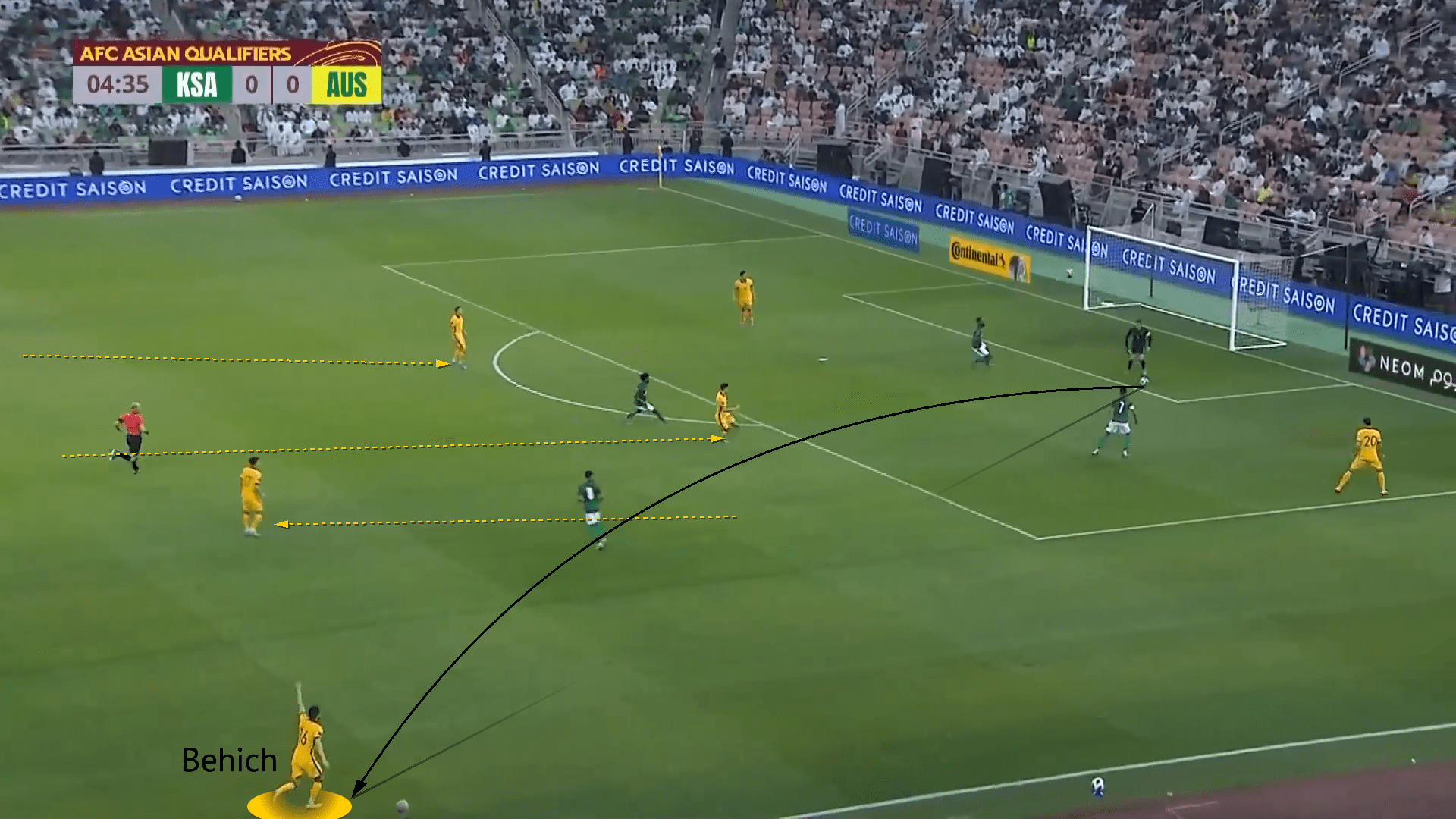
Mathew Ryan’s average of less than 1 pass into the final third per 90 during qualifying shows how rarely Australia’s build-up is direct. Ranking well for forward passes per 90 and total passing accuracy, Ryan is a cool-headed goalkeeper that can be relied upon with his feet. The figure above shows his composure, as he is pressured by multiple Saudi Arabia players with short passing options cut out, he clips the ball into Behich to relieve pressure after drawing in four opponents.
From this image, we can also see the Australian midfielders dropping back to overload the first phase of build-up. This is a regular occurrence for the Socceroos when playing a 4-2-3-1, allowing the full-backs to advance. It is common for the central midfielders to start high and then drop back, but this can limit their ability to construct attacks when attempting to play direct toward the attackers.
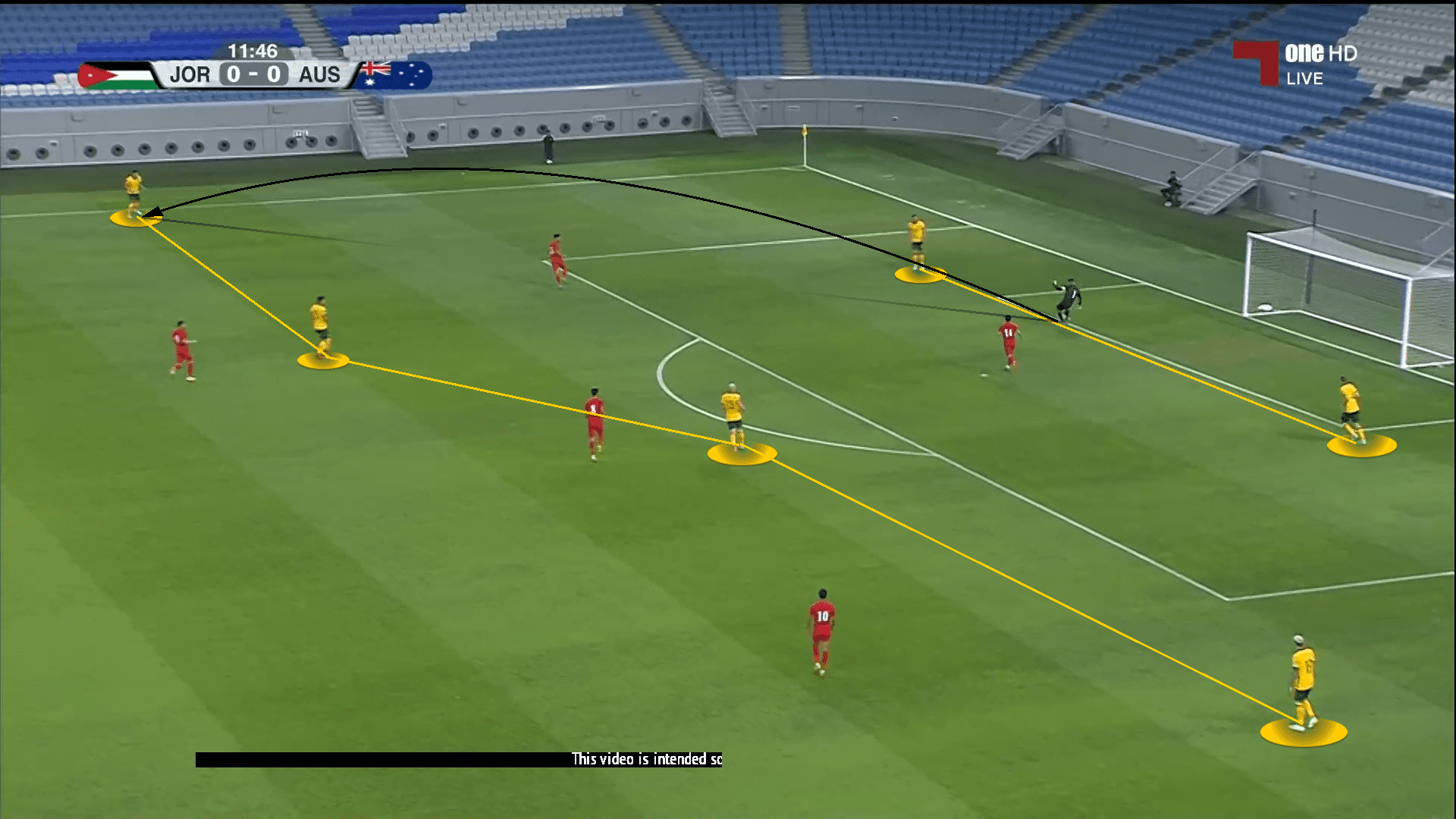
In the image above, Australia have deployed six players in their defensive third in the build-up phase. Riley McGree, the attacking midfielder in the 4-2-3-1, has remained forwards with the attackers. Four players in and around the front line gives Australia more potential to retain possession from a direct ball, and more options to progress out of the build-up phase. The overload in the defensive third usually leaves a full-back free to receive, as it is unlikely that the opposition would commit six players forwards. From here, the full-backs are able to advance and access the forwards to progress possession.
The figure below is, overall, an effective shape for the personnel on the pitch for the Socceroos. In the double pivot, Aaron Mooy has responsibilities in possession that are consistent across any role he plays for Arnold’s team, whether that be in a single pivot or a double pivot. Alongside him, Kenny Dougall has minimal influence in attacking play and is more valuable remaining behind the ball when Australia are in the final third to help defensively. This double-pivot allows the full-backs to advance, suiting Brescia right-back Fran Karačić and Melbourne Victory left-back Jason Davidson.
Out of 75 full-backs to play over 700 minutes in Serie B, Karačić ranks 2nd for passes into the penalty area per 90 with 7.37 and 6th for key passes per 90 with 0.72. Davidson ranks 1st for progressive passes per 90 and 2nd for passes into the final third per 90 out of 51 full-backs to play over 500 minutes in the A-League. The double-pivot also gives McGree the freedom to roam ahead of the ball and receive in dangerous areas. In the Championship last season, McGree ranked in top 25% of the 79 attacking midfielders to play over 500 minutes for progressive runs per 90, whilst ranking above average for most key passing metrics too. With full-backs pushing on, the wingers invert, suiting Awer Mabil’s tendency to move off the wing to attack the box.
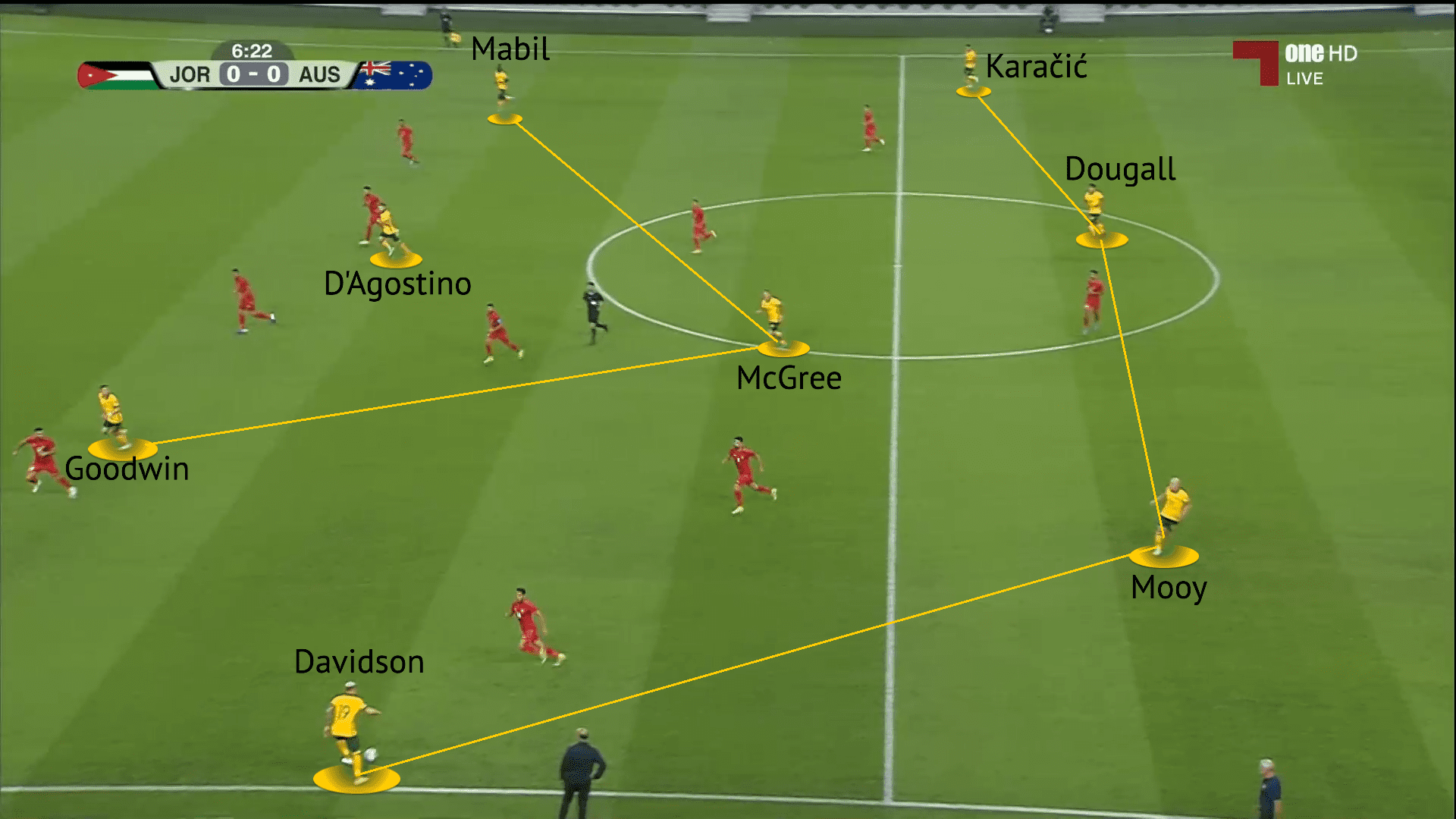
However, against the UAE in the AFC play-off, Graham Arnold fielded a 4-3-3. In the figure below we can see the Socceroos set-up in a 2-3-5 in consolidated possession. Pivot player Mooy is in the centre of the 2-3 base with full-backs Behich and Atkinson to either side. Right-footed right-winger Martin Boyle and left-footed left-winger Craig Goodwin are the width holders. With Mooy positioned in the 2-3 base, central midfielders Hrustic and Jackson Irvine can occupy the half-spaces alongside striker Mathew Leckie.
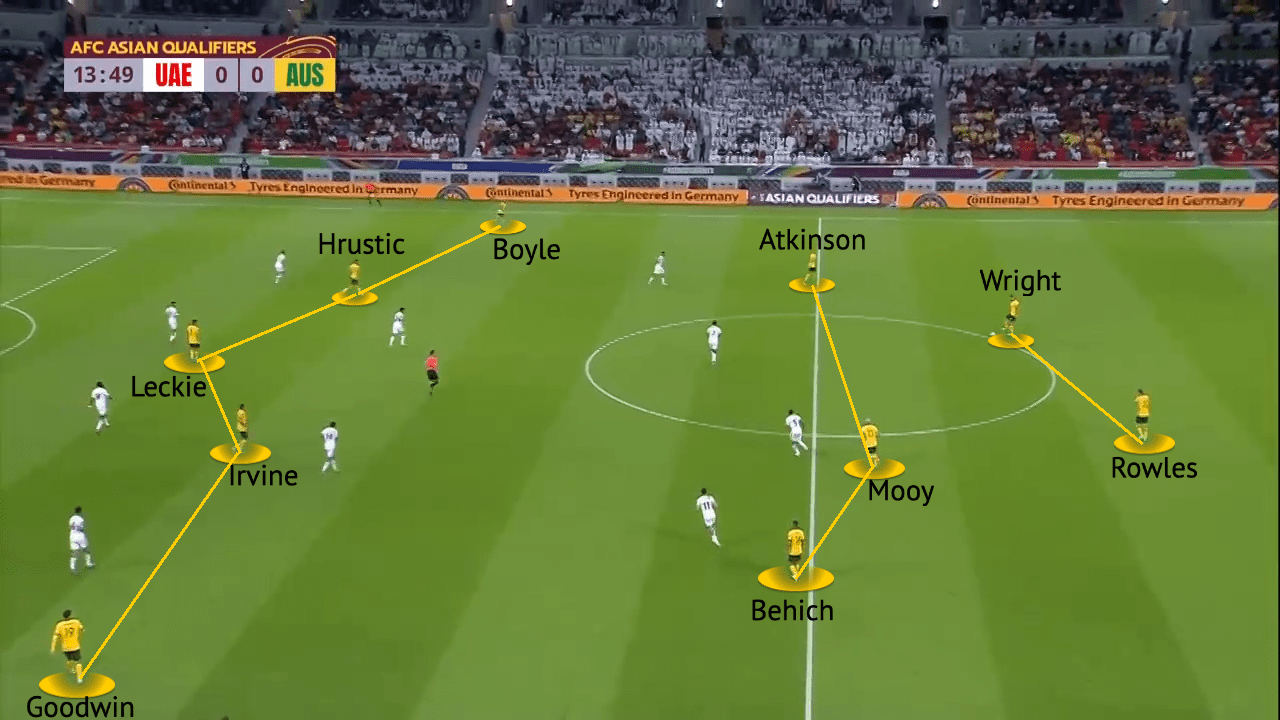
Despite Mooy’s known qualities in possession, as the pivot player, he rarely attempts line-breaking passes. Against the UAE, he only completed 10 forward passes, instead Mooy completed more backwards passes than he usually averages. Regarding the high-pressure, high-stakes fixture, Mooy’s more controlled actions were crucial to Australia’s ball circulation and limited UAE’s chances. With minimal changes expected for Australia’s starting eleven and Peru possessing players that could get the better of Australia’s deficiencies, it is likely that Mooy will look to avoid risks.
With no player in the 2-3 base assigned the responsibility to be the team’s primary progressor, it is shared between them. The full-backs are actively looking to spread the ball to the width holders to progress into the final third. Meanwhile, the centre-backs usually attempt shorter passes. However, as mentioned earlier in the analysis, centre-back Bailey Wright tends to attempt long passes, with right-to-left diagonals a habit of his. As shown in the image below, Behich receives the diagonal as the left-width holder. With Wright in the side, the left-width holder (usually winger Goodwin) tends to stay wider, and longer than the right-width holder does, due to the potential of the diagonal.
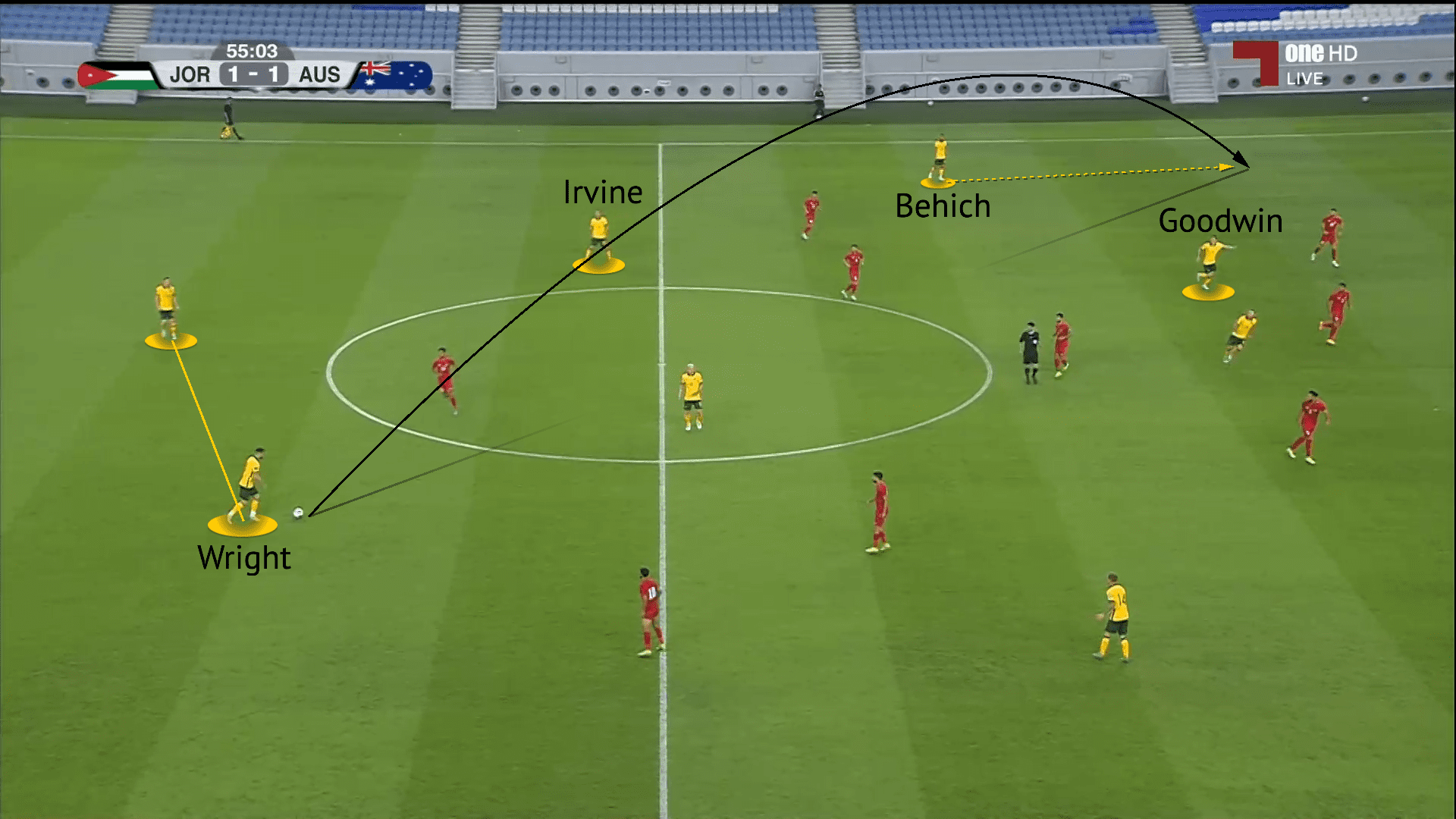
As shown in the image above, Australia look to use rotations to aid ball progression. Central midfielder Irvine has dropped into the 2-3 base, freeing up Behich to advance and cause Goodwin to invert. The rotations also occur on the right-wing. In the figure below, Ajdin Hrustic has drifted to the right-wing with Boyle taking Hrustic’s position in the right half-space. Hrustic receives in the widest channel off Atkinson, similar to 2-3 base progression, and plays a channel ball for Boyle to run onto.
The rotations on the left can harm the opposition. As Goodwin has shown at Adelaide United this season, his anticipation when receiving through passes to create left-footed shooting angles is impressive, especially from the left half-space channel. However, his threatening deliveries into the box from the widest channel, combined with the freedom of ghosting into the box, suit his role in the team as the left width-holder. This gives Irvine license to find attackers and thread passes for the forward line from a more advanced position than the 2-3 base, with Behich back in the 2-3 base.
On the other hand, the right-wing rotation between Hrustic and Boyle are much more effective. Hrustic’s technical proficiency allows him to receive and retain possession in tight areas, alongside being able to execute different types of passes to progress and penetrate. Meanwhile, Boyle occupying positions off the striker in the right half-space is very similar to the areas he occupies at club level with Al-Faisaly in his strike partnership with Júlio Tavares. However, Boyle can also perform the right width holder role to a good standard, with his explosive dribbling and ruthless movement certain to trouble opposition defences.
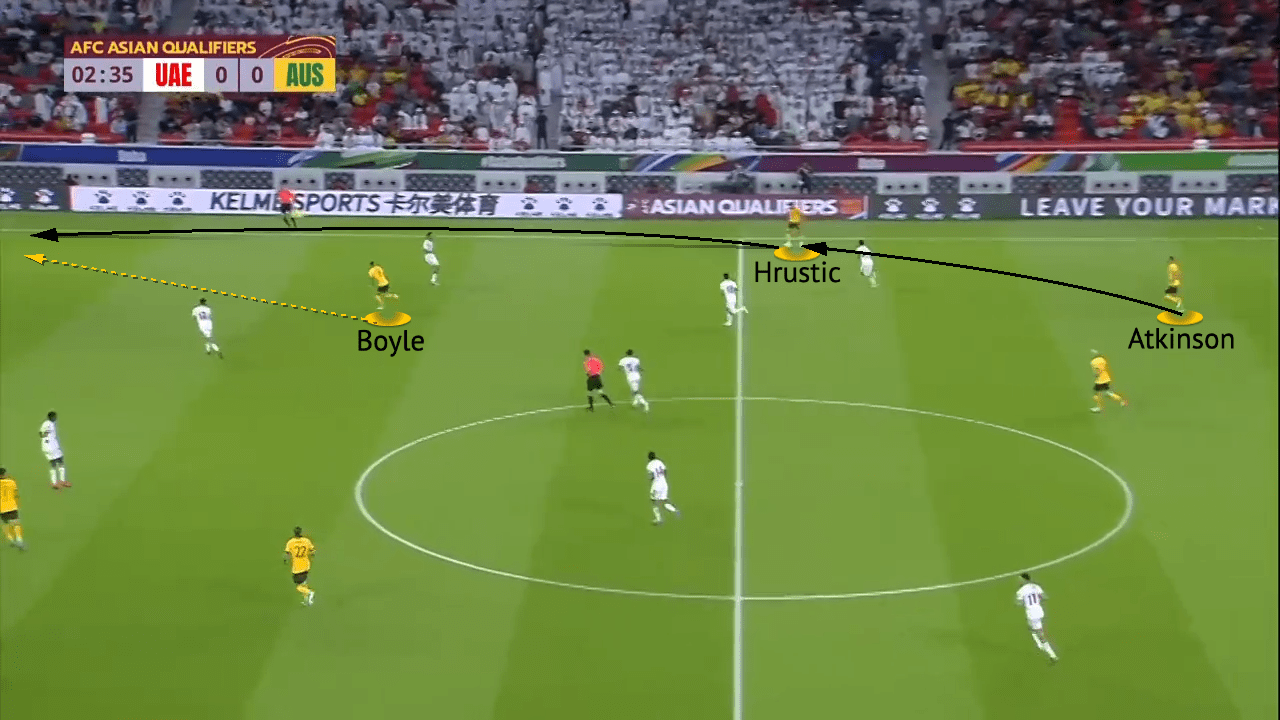
The two images above and below display a common route of penetration from the Socceroos in their 4-3-3. With the width-holder drawing out the opposition full-back, the half-space player can make a line-breaking run in behind to receive a channel ball. In the example above, Boyle is the right half-space player running in behind after the rotation with Hrustic we just mentioned. In the example below, Goodwin has pulled out the opposition full-back and allows Irvine to make the run from the left half-space to receive a chipped pass from Behich. This strategy is effective for Arnold’s team, as it perturbates the opposition defence to create the space to penetrate and attack the box. St. Pauli’s Jackson Irvine is a willing runner, constantly an outlet and option to make these runs.
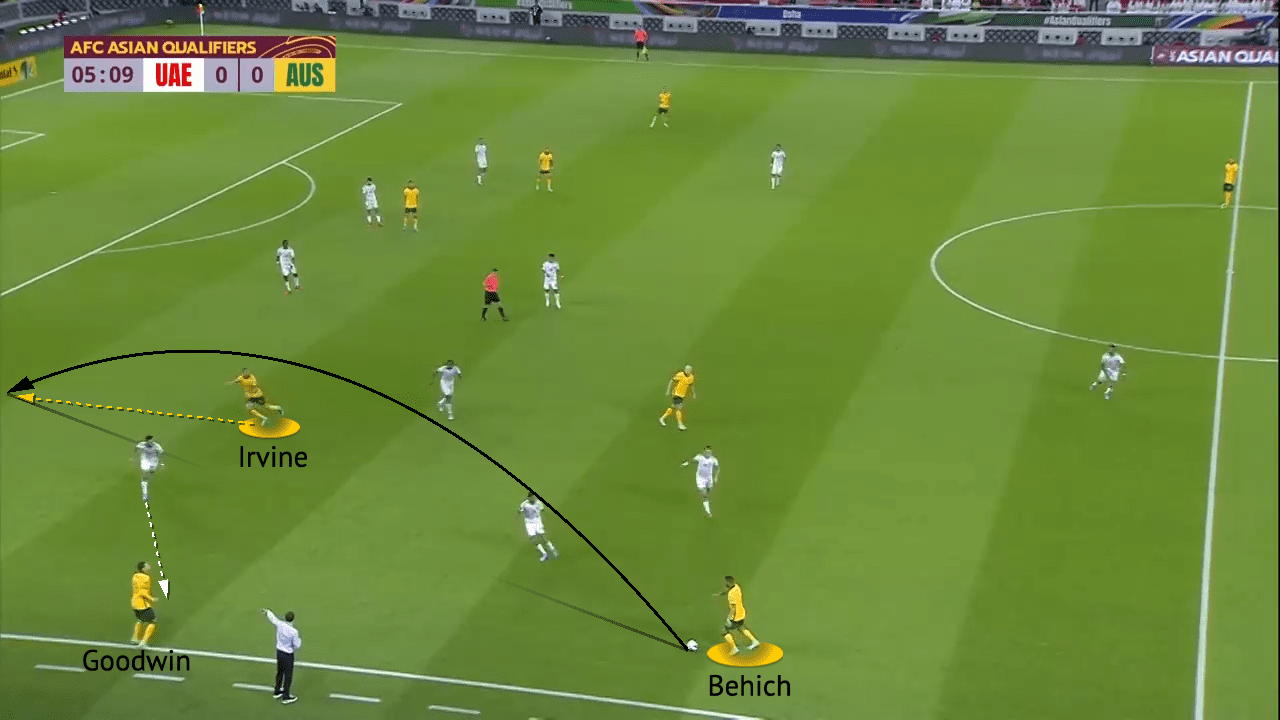
Attacking set-pieces
Australia’s main set-piece takers are right-footed Mooy and left-footed Goodwin, with left-footed Hrustic another option. Goodwin is capable of delivering a quality outswinging corner, but Arnold prefers his team to deliver inswinging corners. With both Mooy and Goodwin on the pitch, one player would be stood to take the inswinging corner with the other being a short corner option. If Hrustic takes corners, he usually has no short corner option so looks to whip the ball into the six-yard box.
Typically, Hrustic will sit on the edge of the box with Aziz Behich to win second balls and possibly have shooting opportunities. This situation created Hrustic’s winning goal against UAE, connecting well with a volley from a headed clearance. Inside the box, the Socceroos usually attack with five players. Four players will start deeper before making runs towards the six-yard box, with the remaining player near the goalkeeper. The main targets from corners and free-kicks are the centre-backs. Sunderland’s Bailey Wright won 66.5% of his aerial duels in League One last season and always impacts the attacking set-pieces. Stoke City’s Harry Souttar is the biggest threat from set-pieces, scoring 6 goals in just 10 caps as a centre-back, but is currently injured. His goal-scoring void can be filled by Milos Degenek, Jackson Irvine, and Trent Sainsbury, who all rank in the top 20% of the 303 outfielders that have played more than 500 minutes in AFC World Cup qualifiers for aerial duel success rate.
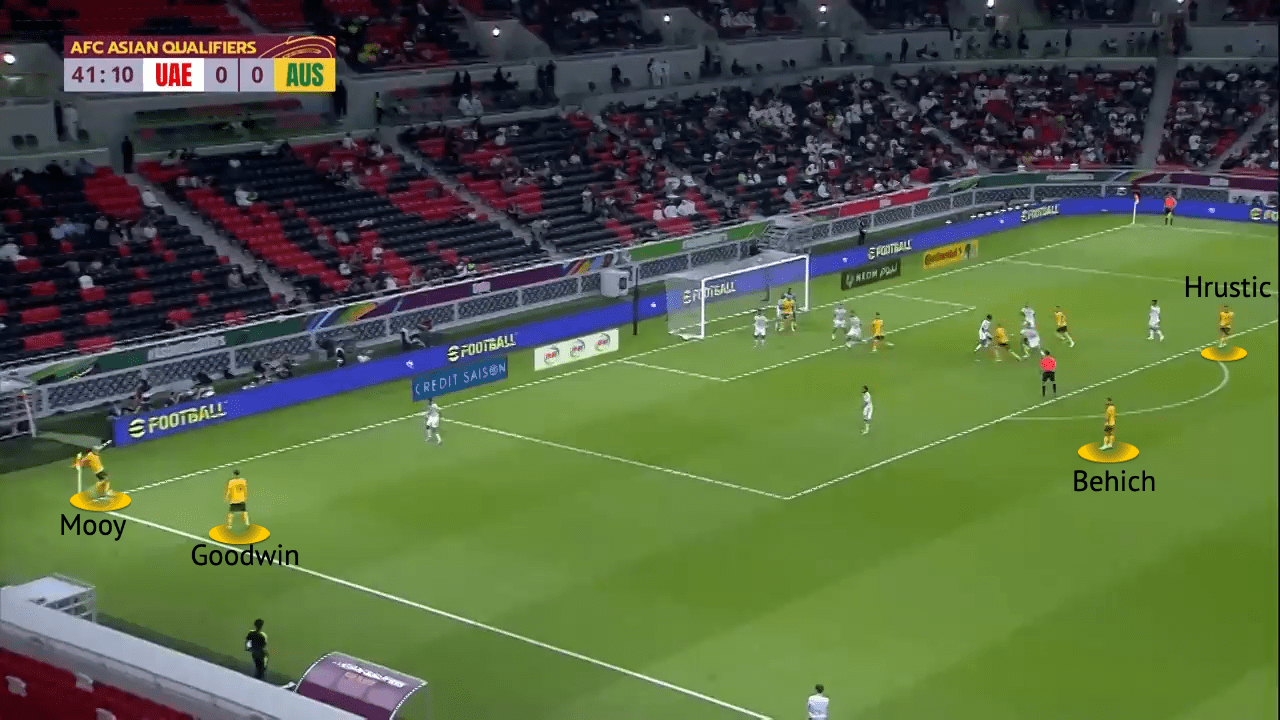
The two centre-backs usually split, with one attacking the front zone and the other drifting near the back post. This strategy often ensures that Australia will have a threat for the near-post and deeper deliveries. Mooy’s corners tend to be flatter and more towards the front zone. Meanwhile, Goodwin’s inswinging and outswinging deliveries are typically deeper towards the back post. This can sometimes result in a slight change of movement from the players in the box, with more players moving towards the back post. However, overall, it is likely that the Socceroos will have two players making movements towards the front zone and two players moving near the middle zone and the back post.
Alongside the centre-backs will be Jackson Irvine and the striker. As mentioned earlier, Irvine has a good aerial duel success rate and his ability to time his movement to connect with the delivery is essential to this. Meanwhile, the striker’s movement is usually reactive to the first contact from the corner. Melbourne City’s Jamie Maclaren will look to stay between the posts, alert and ready to convert in danger areas, as a poacher rather than making runs from deep. On the other hand, Melbourne Victory’s Nicholas D’Agostino tends to make runs to the front zone from deep, initially starting his run alongside his centre-back teammates. Mathew Leckie has a bit more varied movement, able to hover near the six-yard box or the penalty spot depending on what is required.
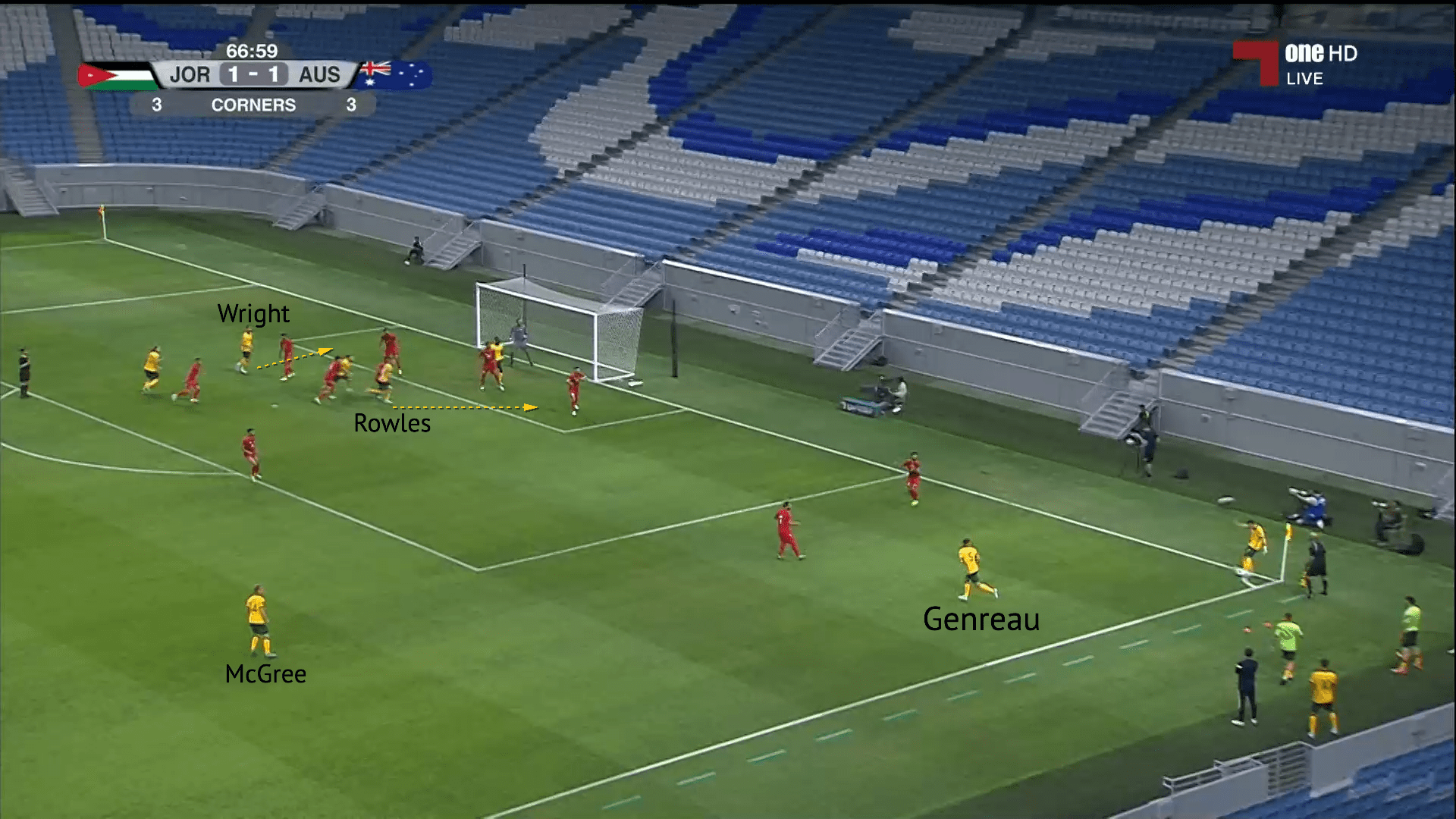
The figure above is an example against Jordan of Australia’s usual corner set-up. With Goodwin taking the inswinging corner, right-footed Denis Genreau of Toulouse is the short corner option. Riley McGree has drifted wide from a central position on the edge of the box to provide another passing option. McGree and Hrustic are worthy selections for the edge of the box due to their decent ball-striking, especially with their left foot. In the figure, we can see that centre-back pairing Wright and Kye Rowles, new signing of Heart of Midlothian, make opposing runs. Rowles and D’Agostino attack the front post, whereas Wright and Irvine move behind towards the back post.
Australia regularly place an attacker near the opposition goalkeeper from corners. In the example above, this player is Awer Mabil, who managed to react and stay onside to flick the ball into the net and give the Socceroos the lead. However, Martin Boyle has also performed this role, but he is not as effective as Mabil. Mabil can influence the goalkeeper and pick up free spaces in the six-yard box to give himself the best possible goal-scoring opportunities. But as shown in the example below against Saudi Arabia, he can move away from the middle zone and the goalkeeper into a less threatening area, whilst drawing out two Saudi defenders to decongest the box.
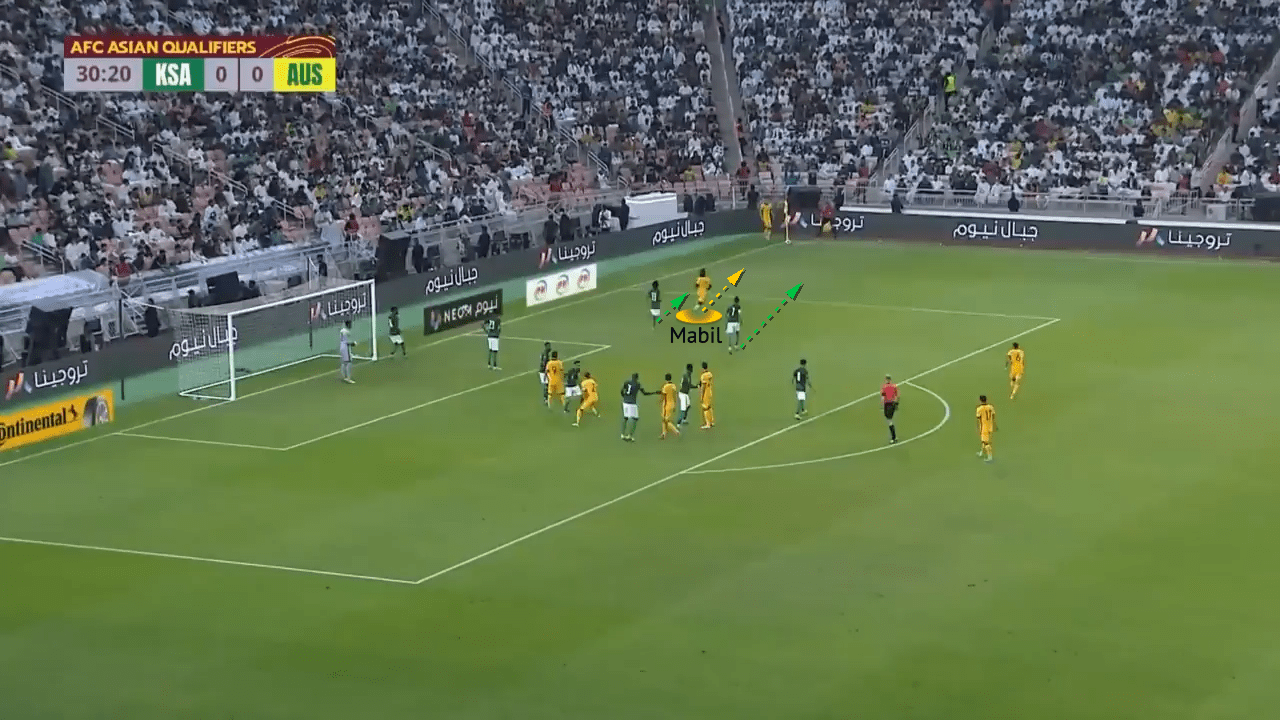
Out of possession
Regardless of their starting formation, the Socceroos set up out of possession in a 4-4-2. Usually only starting with one striker, the attacking midfielder in the 4-2-3-1 or the most attacking central midfielder in the 4-3-3 will become the second striker out of possession. This player is usually Ajdin Hrustic. His club team Eintracht Frankfurt rank 5th in the Bundesliga for PPDA, but Hrustic’s interceptions per 90 is average for the league and he ranks 116th out of 119 central midfielders to play over 500 minutes in the Bundesliga for defensive duels won percentage.
Australia rarely press the opposition goalkeeper. Instead, they look to press one of the centre-backs. As one striker presses the centre back, the other striker will drop behind near the opposition’s pivot player defensive midfielder. This pendulum-like movement means the passing lane into the pivot player is blocked, or the striker is close enough to engage and regain possession if the pivot player does receive. This attempt from the two pressing strikers to prevent central progression dictates opposition play into the wide area to the full-back, or back to the goalkeeper.

To create the 4-4-2, the wingers will drop back to make the first bank of four alongside the two remaining midfielders. It is likely that Irvine and Mooy will be the out-of-possession double-pivot against Peru. Mooy is defensively average, nowhere near the standard of his in-possession capabilities, but his partner in Irvine is more accomplished defensively. With PAdj interceptions of 7.61 per 90, the St. Pauli midfielder ranks 19th out of 118 central midfielders to play more than 500 minutes in the 2. Bundesliga.
The double-pivot can occasionally be overloaded after the opposition have broken the first line of pressure in the build-up phase. If the opposition are set up in a 4-3-3, Australia’s two strikers are responsible for preventing the opposition pivot player from receiving, leaving Irvine and Mooy to man-mark the opposition central midfielders. However, if the pivot player pulls away from Australia’s front two, he can overload Irvine and Mooy 3vs2. This situation occurred against the UAE, with the pivot player breaking forwards unmarked.
The Socceroos must be wary of this, with Peru invariably lining up in a 4-3-3. It is likely that Peru’s pivot player will be Renato Tapia, with Yoshimar Yotún and Sergio Peña operating ahead of him. Not only will the set-up give Peru opportunities to have numerical superiority, but this combined with the calibre of players mentioned will give them qualitative superiority. Tapia ranks 7th for successful dribble percentage out of 50 central midfielders to play over 500 minutes in CONMEBOL qualifying, showing he has the ability to beat a player when breaking forward. Additionally, Yotún and Peña rank 9th and 14th for progressive passes per 90 with nearly 7 passes each. With many of the wide midfielders that have been selected in the Peru squad likely to drift inside, this further increases the potential for the Australian double pivot to be overloaded.
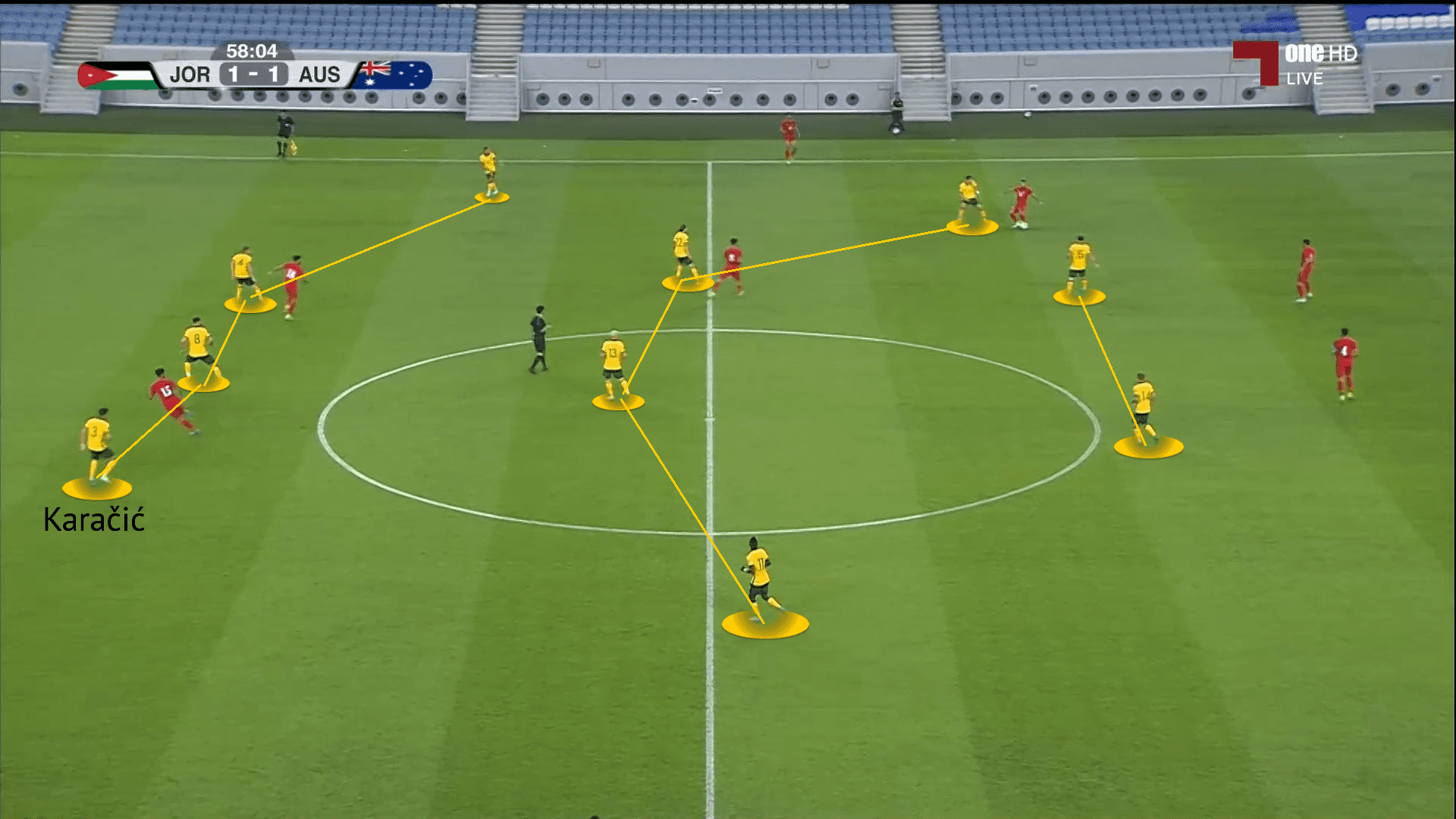
The defensive unit will be positioned in a high line, compressing space for the opposition. This requires maximum concentration and communication across the defensive line to ensure correct positioning from all players. The correct positioning will help lead to the opposition being offside. However, an essential element to a high line is the goalkeeper. The goalkeeper must be prepared to leave his line to sweep up balls in behind the Australian defence, which is something that Ryan does to a great standard with the most interceptions than any goalkeeper in AFC qualifying.
The image above shows how just the smallest error can have large implications. Right-back Karačić has followed the movement of the Jordanian attacker but became the deepest defender by dropping behind the rest of the defensive line. With the attacker’s movement being a blindside run for Australia’s centre-backs, Karačić’s tracking has played the attacker onside and isolated himself from the defensive unit.
The image below shows a dysfunctional press in a 4-2-3-1 from the Socceroos. The starting eleven selected for this game was fairly rotated, but again it shows how one player’s loss of focus can lead to the opposition gaining an advantage. As D’Agostino forces the ball to the centre-back wide, McGree has to dart out to the defender after being in the wrong position. McGree was still too far away to pressure the centre-back, with Mabil also static.
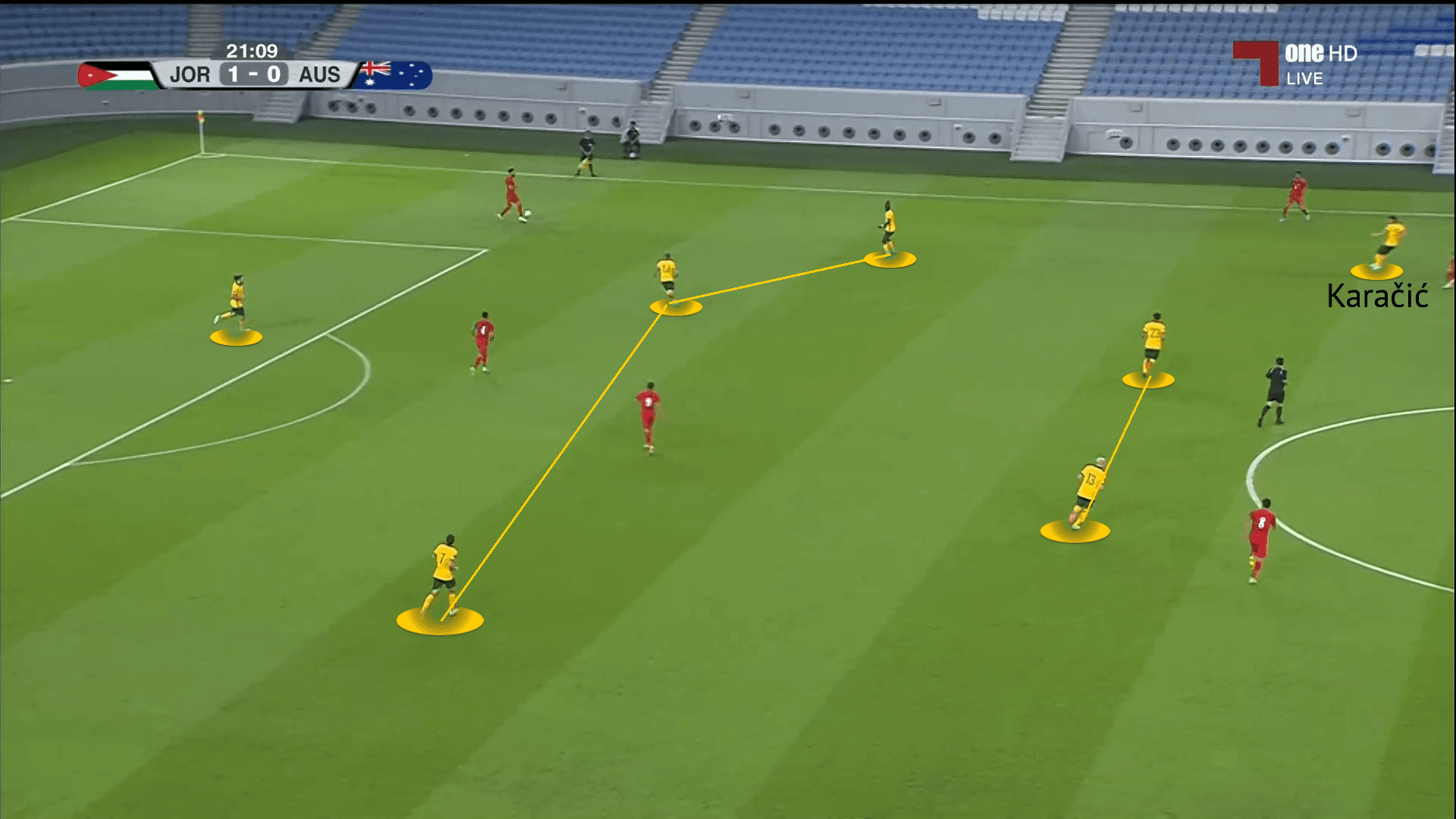
As we can see from the two figures above and the figure below, Arnold instructs his full-backs to man-mark and follow the opposition winger. The two images above show Karačić following his man into the opposition half and behind Australia’s defensive line.
The example below clearly shows the impact of the full-back man-marking. Right-back Nathaniel Atkinson has followed the opposition left winger deep into the UAE half, subsequently disbanding from the defensive line by 30 yards. The winger plays a one-two with the central midfielder to get in behind Atkinson due to his dynamic superiority. Space behind the full-backs is regularly available for the opposition, as a result of the man-marking. Peru could really harm the Socceroos with this space available, as Christian Cueva and André Carrillo are expected to start on the wings. Out of the 57 attackers to play over 500 minutes in CONMEBOL qualifying, Carrillo ranks 5th meanwhile Cueva ranks 11th.
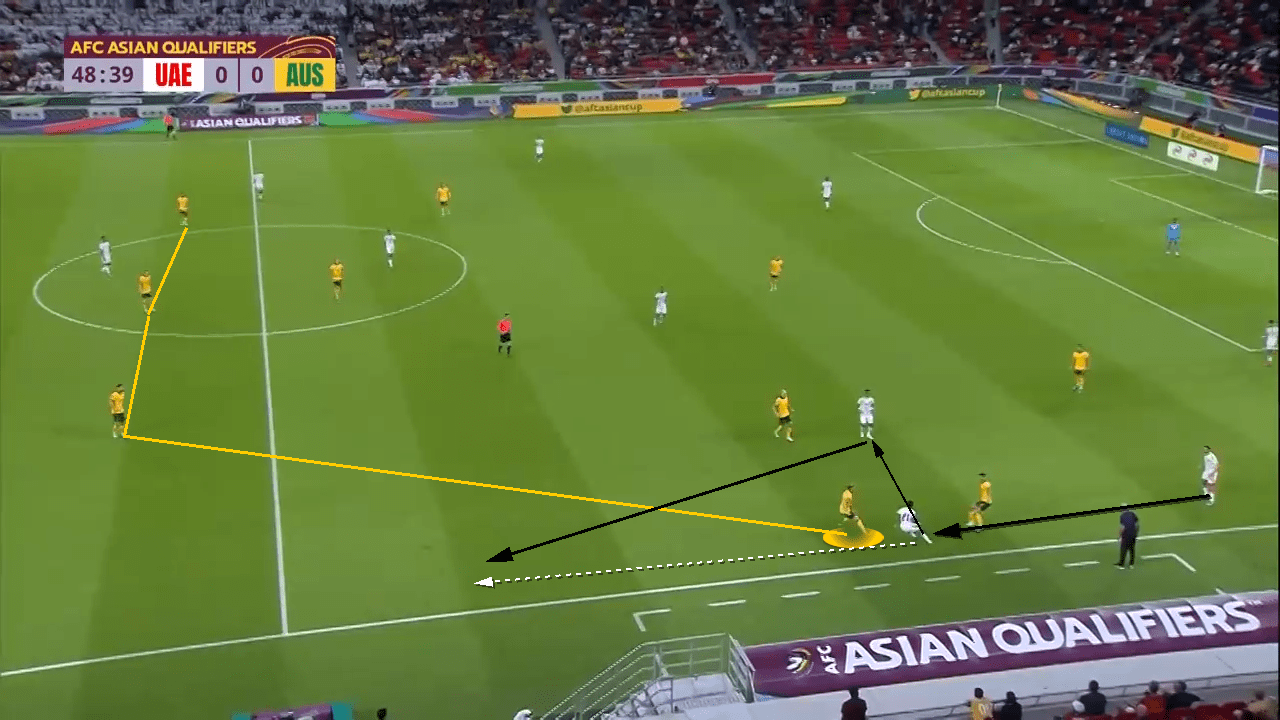
Defending set-pieces
When defending corners, it is common for Australia to have two players occupying the front zone and Aaron Mooy stationed in the middle zone. Elsewhere in the box, the Socceroos will man-mark the opposition. In the example below, there is a 5vs5 in the box man-marking, with Hrustic and Martin Boyle on the edge of the box. Hrustic and Boyle can drop into the 18-yard box to snuff out danger, whilst remaining aware of their opponents on the edge of the box. Australia man-markers like to engage and make contact with their opposition, to constantly feel and handle their movement whilst reading the ball flight from the corner.
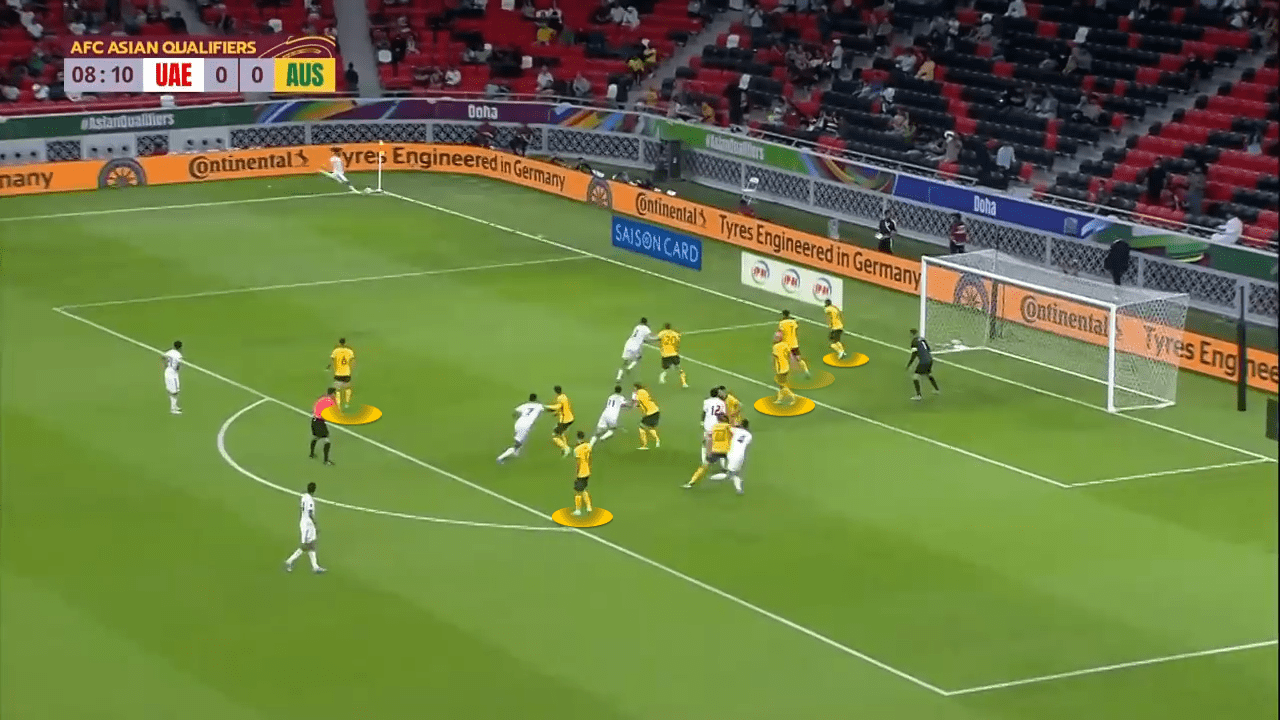
When the opposition adds another player into the box, Australia assign one of their players from the edge of the box to drop in and mark them. If the opposition player moves in front of the goalkeeper, Graham Arnold will use his marking player as a buffer between the opponent and goalkeeper Mathew Ryan. This is shown below, as it was a strategy used by Jordan.
Despite his lack of minutes at Real Sociedad this season, the Socceroos captain is always confident between the sticks representing his nation. His decision-making from opposition set-pieces is particularly impressive, especially when considering his lack of football recently. Ryan is comfortable leaving his line and collecting high balls, even in a congested area, but understands when it would be more suitable to deflect or punch the ball away from danger. From the corner kick in the image above, Ryan’s starting position is perfect for dealing with the opposition’s outswinging delivery and instantly makes the goalkeeper favourite to collect any ball that enters the six-yard box.
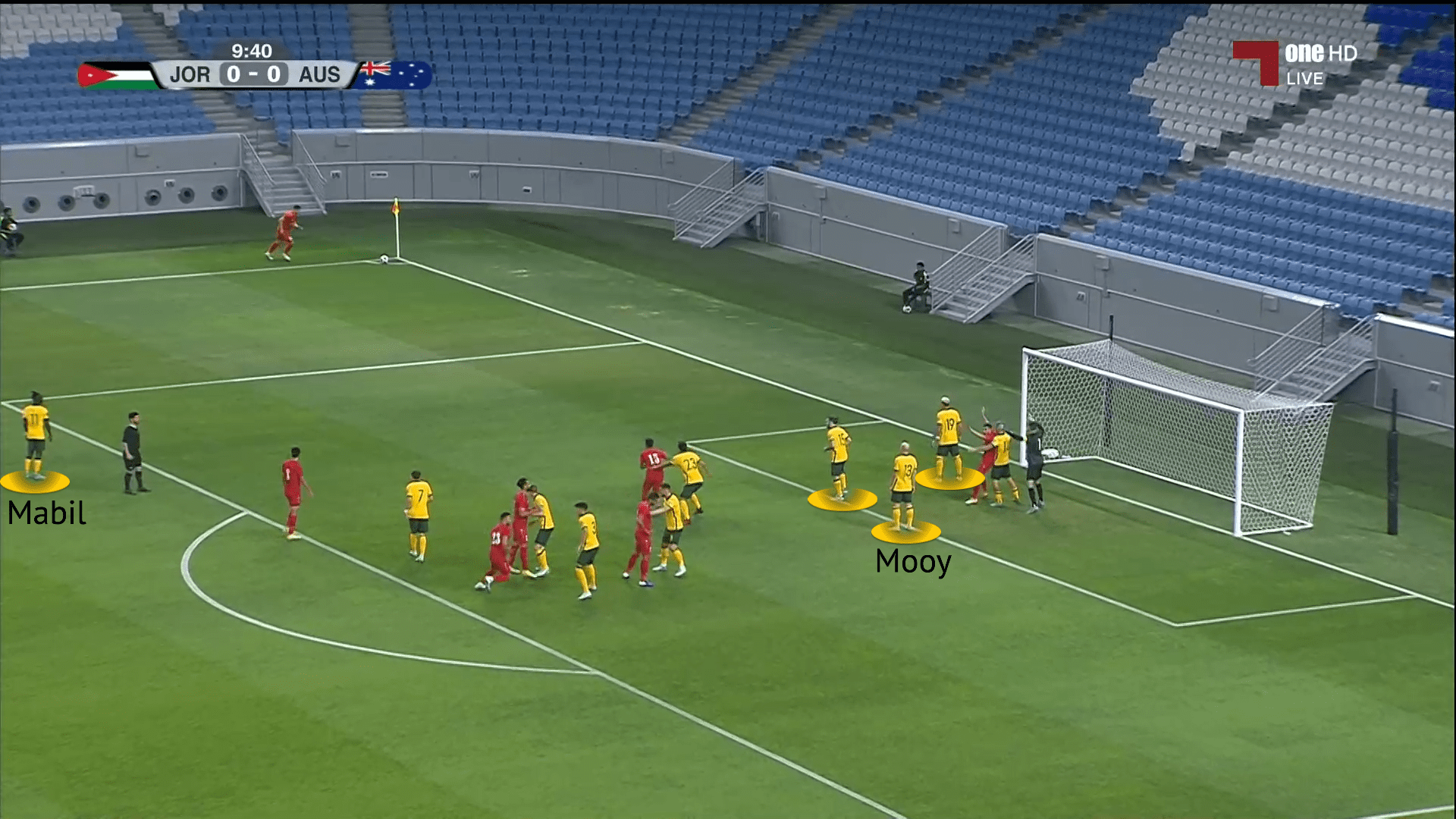
Australia are also alert to any opposition short corners. In the example below against Japan, their man-marking system allows them to follow the short corner receiver, with a front-zone player chasing behind to prevent a Japanese overload. The front zone player moving out is a good selection, as they are nearest to the corner taker and short corner option and have a teammate also occupying the front zone who is able to move and intercept any balls entering the zone.
With opposition committing players forward, Australia bring all outfield players back into the box. This can leave opposition players unmarked on the edge of the box, and often leads to the opposition taking low xG shots from distance, but without much pressure on the shooter. Additionally, it can be tough for Australia to start a counter-attack and generally relies on Mabil to break away at speed with good distribution from Ryan if the Socceroos do want to play direct after the regain. However, Ryan is always looking to start a counter-attack after collecting the opposition set-piece, usually with a long kick. A potential area from defensive set-pieces that could be exploited is from free-kicks. It is common for teams to have a man lay behind the wall (“draught excluder”), allowing the wall to jump whilst stopping the opposition from shooting under the wall. This is a strategy that Australia do not use, and is, therefore, an opportunity for the opposition to test Mathew Ryan.
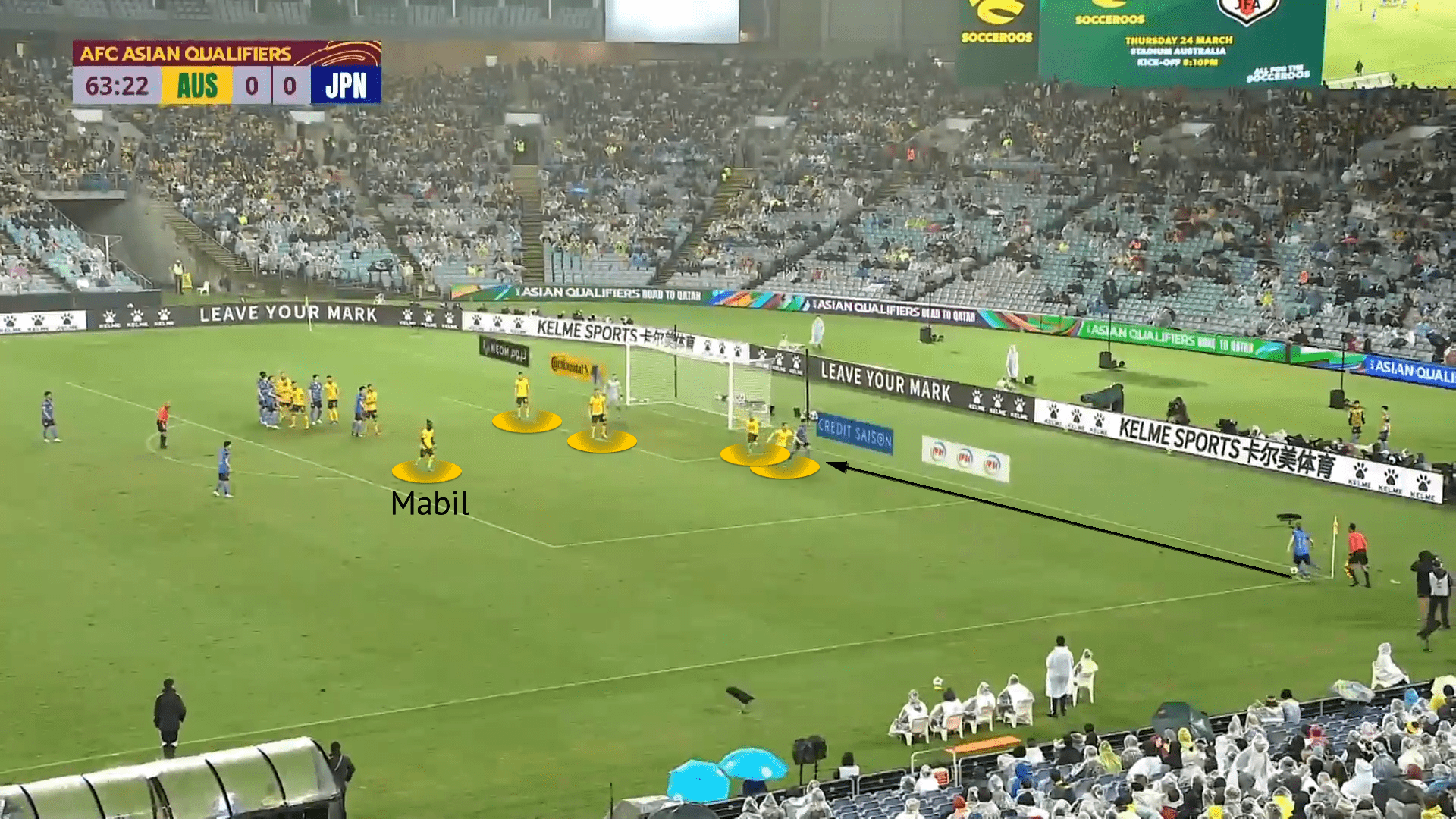
Conclusion
After some poor results to end the group stage of AFC World Cup qualifying, Australia managed a decisive win against the United Arab Emirates and are one game away from the 2022 World Cup. However, the Socceroos face tough competition in the form of Peru. The South American nation have picked up wins in crucial games in 2022, beating qualification rivals Colombia and drawing with Ecuador before beating Paraguay in a must-win game on the last qualifier.
This team analysis and scout report has discussed Graham Arnold’s tactics that could take the Socceroos to their fifth consecutive World Cup. If Australia can get revenge on their 2018 World Cup opponents, they would enter Group D and play more familiar faces. Group D features France and Denmark, who were both also in Australia’s group at the 2018 World Cup, and Tunisia. It would be another challenging group if they do qualify, but the Socceroos will dream of playing on the biggest stage once again.






Comments